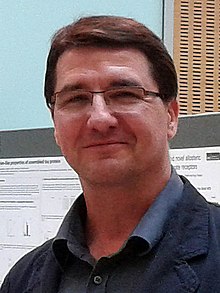Hilmar Bading
Hilmar Bading (born 1958) is a German physician and neuroscientist. His work on neuronal calcium signaling and gene regulation in the nervous system, and on the involvement of extrasynaptic NMDA receptors in neurodegenerative disorders has been widely cited.

Education and career
Hilmar Bading was born in Berlin on 3 November 1958. He studied medicine from 1978 to 1984 at Heidelberg University (MD in 1984) and carried out his MD Thesis at the Max Planck Institute for Medical Research, Heidelberg, with Wilhelm Hasselbach on the calcium transport ATPase in skeletal muscle. He received postdoctoral training in the laboratory of Karin Mölling at the Max Planck Institute for Molecular Genetics, Berlin, Germany (1985–1989) and in the laboratory of Michael E. Greenberg at Harvard Medical School, Boston, US (1989–1993). From 1993 to 2001 he was a staff scientist at the MRC Laboratory of Molecular Biology, Cambridge, UK. Since 2001 he has been professor of neurobiology and director of the Neurobiology Institute and the Interdisciplinary Center for Neurosciences (IZN) at Heidelberg University.[1][2]
He is co-founder of FundaMental Pharma GmbH, Heidelberg.[3]
Research
Hilmar Bading is noted for his work on neuronal calcium signaling and gene regulation in the nervous system.[4] He identified calcium as the principal second messenger in the coupling of neuronal activity to gene expression and characterized the processes that mediate the dialogue between the synapse and the nucleus.[5][6] His work highlighted the spatial aspects of calcium signals[7][8] and in particular the importance of nuclear calcium in governing activity-dependent gene expression and adaptations in the nervous system that include memory formation and acquired neuroprotection.[9][10][11][12] The discovery of toxic signaling by extrasynaptic NMDA receptors that antagonizes gene regulation by synaptic activity and causes neuronal dysfunction and cell death[13][14] contributed to the understanding of neurodegenerative disorders including Huntington's disease, Alzheimer's disease, and amyotrophic lateral sclerosis (ALS).[13][14][15][16][17][18]
Awards and honors
2001: Wolfgang-Paul Prize of the Alexander von Humboldt Foundation[19]
2016: Innovation Prize of the German BioRegions[20]
References
- "Neurobiology". Heidelberg University. Retrieved 2016-10-18.
- "Interdisciplinary Center for Neurosciences (IZN)". Heidelberg University. Retrieved 2016-10-18.
- "TP-Mieter und Assoziierte stellen sich vor: 'Es nützt dem Patienten nichts, wenn die Ideen in der Schublade liegen'" [TP tenants and associates imagine: 'It does not help the patient if the ideas lie in the drawer']. Technologiepark Heidelberg (in German). Retrieved 2016-10-18.
- Forschung, biotechnologie.de - Initiative des Bundesministeriums für Bildung und Forschung. "Biotechnologie.de - Menschen". www.biotechnologie.de (in German). Retrieved 2016-09-07.
- Bading, H.; Ginty, D. D.; Greenberg, M. E. (1993-04-09). "Regulation of gene expression in hippocampal neurons by distinct calcium signaling pathways". Science. 260 (5105): 181–186. doi:10.1126/science.8097060. ISSN 0036-8075. PMID 8097060.
- Hagenston, Anna M.; Bading, Hilmar (2011-11-01). "Calcium signaling in synapse-to-nucleus communication". Cold Spring Harbor Perspectives in Biology. 3 (11): a004564. doi:10.1101/cshperspect.a004564. ISSN 1943-0264. PMC 3220353. PMID 21791697.
- Ginty, D. D. (1997-02-01). "Calcium regulation of gene expression: isn't that spatial?". Neuron. 18 (2): 183–186. doi:10.1016/s0896-6273(00)80258-5. ISSN 0896-6273. PMID 9052789.
- Hardingham, G. E.; Chawla, S.; Johnson, C. M.; Bading, H. (1997-01-16). "Distinct functions of nuclear and cytoplasmic calcium in the control of gene expression". Nature. 385 (6613): 260–265. doi:10.1038/385260a0. ISSN 0028-0836. PMID 9000075.
- Bading, Hilmar (2013-09-01). "Nuclear calcium signalling in the regulation of brain function". Nature Reviews. Neuroscience. 14 (9): 593–608. doi:10.1038/nrn3531. ISSN 1471-0048. PMID 23942469.
- "Heidelberg Researchers Identify Neuron Survival Programmes - University of Heidelberg". www.uni-heidelberg.de. Retrieved 2016-09-07.
- "Mediaserver – Universität Heidelberg: Audio". archiv.ub.uni-heidelberg.de. Retrieved 2016-09-07.
- Campus TV: Dem Langzeitgedächtnis auf der Spur, retrieved 2016-09-07
- Milnerwood, Austen J.; Gladding, Clare M.; Pouladi, Mahmoud A.; Kaufman, Alexandra M.; Hines, Rochelle M.; Boyd, Jamie D.; Ko, Rebecca W.Y.; Vasuta, Oana C.; Graham, Rona K. (2010-01-28). "Early Increase in Extrasynaptic NMDA Receptor Signaling and Expression Contributes to Phenotype Onset in Huntington's Disease Mice". Neuron. 65 (2): 178–190. doi:10.1016/j.neuron.2010.01.008. ISSN 1097-4199. PMID 20152125.
- Talantova, Maria; Sanz-Blasco, Sara; Zhang, Xiaofei; Xia, Peng; Akhtar, Mohd Waseem; Okamoto, Shu-ichi; Dziewczapolski, Gustavo; Nakamura, Tomohiro; Cao, Gang (2013-07-02). "Aβ induces astrocytic glutamate release, extrasynaptic NMDA receptor activation, and synaptic loss". Proceedings of the National Academy of Sciences of the United States of America. 110 (27): E2518–2527. doi:10.1073/pnas.1306832110. ISSN 1091-6490. PMC 3704025. PMID 23776240.
- "Proteins Produced by Activated Neurons Could Protect Against Neurodegeneration". 2015-08-24. Retrieved 2016-09-07.
- Okamoto, Shu-ichi; Pouladi, Mahmoud A.; Talantova, Maria; Yao, Dongdong; Xia, Peng; Ehrnhoefer, Dagmar E.; Zaidi, Rameez; Clemente, Arjay; Kaul, Marcus (2009-12-01). "Balance between synaptic versus extrasynaptic NMDA receptor activity influences inclusions and neurotoxicity of mutant huntingtin". Nature Medicine. 15 (12): 1407–1413. doi:10.1038/nm.2056. ISSN 1546-170X. PMC 2789858. PMID 19915593.
- Hardingham, Giles E.; Bading, Hilmar (2010-10-01). "Synaptic versus extrasynaptic NMDA receptor signalling: implications for neurodegenerative disorders". Nature Reviews. Neuroscience. 11 (10): 682–696. doi:10.1038/nrn2911. ISSN 1471-0048. PMC 2948541. PMID 20842175.
- Parsons, Matthew P.; Raymond, Lynn A. (2014). "Extrasynaptic NMDA Receptor Involvement in Central Nervous System Disorders". Neuron. 82 (2): 279–293. doi:10.1016/j.neuron.2014.03.030. PMID 24742457.
- "The Wolfgang Paul Award". Alexander von Humboldt Foundation. Retrieved 2016-10-18.
- "Nasenspray gegen Nervenleiden, Organmodelle statt Tierversuche, Viren gegen Krebs: Innovationspreis der BioRegionen" [Nasal spray against nervous disorders, organ models instead of animal testing, virus against cancer: Innovation Award BioRegions]. Bio Deutschland (Press release) (in German). Retrieved 2016-10-18.